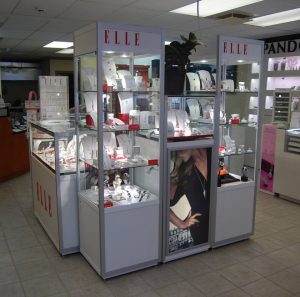STARTING A KIOSK BUSINESS
Choosing the right size for starting your kiosk business.
Typically, mall managers have size requirements or limitations for mall kiosks, depending on the purpose and location of each kiosk. Within those parameters, though, you can create a kiosk of virtually any size, overall shape, or configuration.
Welcome back to our series about making money with mall kiosks. In this article, we’ll help you get your new business off to the best possible start by choosing the right size kiosk for your merchandising needs. Your goal is to create a layout and design that draws attention to your kiosk and encourages potential customers to stop and shop.
The smartest plan is to work with an experienced kiosk design and manufacturing firm that can advise you on how to not only choose the right size mall kiosk, but make the most of your design to increase sales. Customized design, rather than an “off-the-rack” kiosk, will give your kiosk the greatest individuality and sales appeal.
The “right” size depends on what you sell and who your customers are.
The most common standard kiosk size is 10×10, but that can vary depending on how much storage and display space you will need.
Higher ticket items require more storage space, because you can’t risk leaving them visibly exposed when you aren’t around. If you carry very expensive items, such as jewelry or watches, you’ll want to include a safe, not just cabinet storage. This may require enlarging your kiosk footprint to 10×12. Typically, wireless and cellular devices also need more space, because each display unit has an associated security device.
Walk-through design (as opposed to a walk-around island) enables your customers to view and engage with more merchandise, but that means you’ll have less storage space. So for this configuration you’ll probably want a 10×15 space.
There are numerous other factors to consider in choosing the right size mall kiosk – things like traffic flow, practicalities like electrical needs, etc. If your kiosk will be located outdoors, there are weather-related factors that could affect the size and design of your mall kiosk.
Technology affects size and functionality.
One of the hottest trends with mall (and in-store) kiosks is interactive capability. Some kiosks are entirely self-contained and self-service, while others are part of the overall experience. If your kiosk will include some level of interactivity for your customers, you’ll have to plan for:
Hardware, which can be freestanding, wall-mounted, or set on a tabletop or counter. There are different types of touchscreens, so choose one that is not only the right size, but which provides the best usability experience for customers. You can customize hardware shape, finish, colors, etc. to ensure your hardware is clearly branded. If it’s part of a larger kiosk, make sure it blends attractively with the overall design.
Software, which should make it easy for customers to interact with your kiosk.
Security arrangements that protect your kiosk from hacking as well as physical damage.
In our next installment in this blog series about mall kiosks, we’ll discuss options for security.


